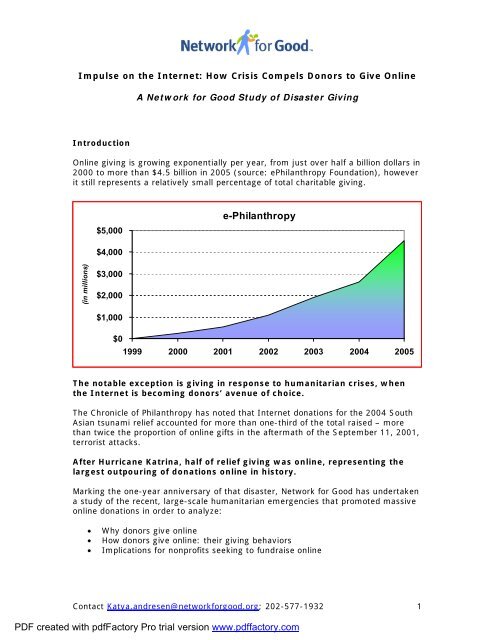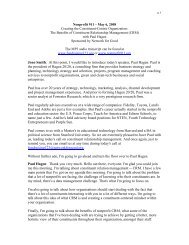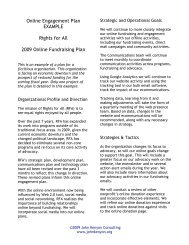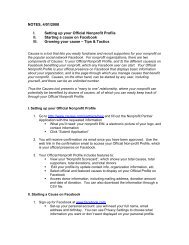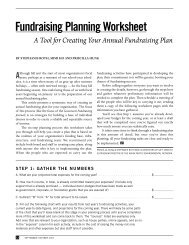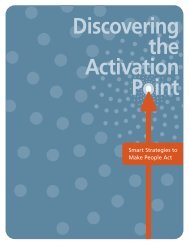Impulse on the Internet: How Crisis Compels ... - Network for Good
Impulse on the Internet: How Crisis Compels ... - Network for Good
Impulse on the Internet: How Crisis Compels ... - Network for Good
You also want an ePaper? Increase the reach of your titles
YUMPU automatically turns print PDFs into web optimized ePapers that Google loves.
<str<strong>on</strong>g>Impulse</str<strong>on</strong>g> <strong>on</strong> <strong>the</strong> <strong>Internet</strong>: <strong>How</strong> <strong>Crisis</strong> <strong>Compels</strong> D<strong>on</strong>ors to Give OnlineA <strong>Network</strong> <strong>for</strong> <strong>Good</strong> Study of Disaster GivingIntroducti<strong>on</strong>Online giving is growing exp<strong>on</strong>entially per year, from just over half a billi<strong>on</strong> dollars in2000 to more than $4.5 billi<strong>on</strong> in 2005 (source: ePhilanthropy Foundati<strong>on</strong>), howeverit still represents a relatively small percentage of total charitable giving.$5,000e-Philanthropy$4,000(in milli<strong>on</strong>s)$3,000$2,000$1,000$01999 2000 2001 2002 2003 2004 2005The notable excepti<strong>on</strong> is giving in resp<strong>on</strong>se to humanitarian crises, when<strong>the</strong> <strong>Internet</strong> is becoming d<strong>on</strong>ors’ avenue of choice.The Chr<strong>on</strong>icle of Philanthropy has noted that <strong>Internet</strong> d<strong>on</strong>ati<strong>on</strong>s <strong>for</strong> <strong>the</strong> 2004 SouthAsian tsunami relief accounted <strong>for</strong> more than <strong>on</strong>e-third of <strong>the</strong> total raised – morethan twice <strong>the</strong> proporti<strong>on</strong> of <strong>on</strong>line gifts in <strong>the</strong> aftermath of <strong>the</strong> September 11, 2001,terrorist attacks.After Hurricane Katrina, half of relief giving was <strong>on</strong>line, representing <strong>the</strong>largest outpouring of d<strong>on</strong>ati<strong>on</strong>s <strong>on</strong>line in history.Marking <strong>the</strong> <strong>on</strong>e-year anniversary of that disaster, <strong>Network</strong> <strong>for</strong> <strong>Good</strong> has undertakena study of <strong>the</strong> recent, large-scale humanitarian emergencies that promoted massive<strong>on</strong>line d<strong>on</strong>ati<strong>on</strong>s in order to analyze:• Why d<strong>on</strong>ors give <strong>on</strong>line• <strong>How</strong> d<strong>on</strong>ors give <strong>on</strong>line: <strong>the</strong>ir giving behaviors• Implicati<strong>on</strong>s <strong>for</strong> n<strong>on</strong>profits seeking to fundraise <strong>on</strong>lineC<strong>on</strong>tact Katya.andresen@network<strong>for</strong>good.org; 202-577-1932 1PDF created with pdfFactory Pro trial versi<strong>on</strong> www.pdffactory.com
MethodologyThis study is based <strong>on</strong> analysis of $24.5 milli<strong>on</strong> in charitable giving <strong>on</strong>line through<strong>Network</strong> <strong>for</strong> <strong>Good</strong> in resp<strong>on</strong>se to three major crises: <strong>the</strong> December 2004 tsunamis,Hurricane Katrina in August 2005 and <strong>the</strong> Pakistan earthquake of October 2005.• Tsunami relief: 82,000 d<strong>on</strong>ati<strong>on</strong>s totaling $11 milli<strong>on</strong> <strong>for</strong> 124 charities• Katrina relief: 107,000 d<strong>on</strong>ati<strong>on</strong>s totaling $13 milli<strong>on</strong> <strong>for</strong> 344 charities• Pakistan relief: 3,100 d<strong>on</strong>ati<strong>on</strong>s totaling $500,000 <strong>for</strong> 75 charitiesAs <strong>the</strong> <strong>Internet</strong>’s largest n<strong>on</strong>profit giving portal, <strong>Network</strong> <strong>for</strong> <strong>Good</strong> has a uniquelyrich set of data <strong>on</strong> <strong>on</strong>line giving. Since its incepti<strong>on</strong> in November 2001, <strong>Network</strong> <strong>for</strong><strong>Good</strong> has processed nearly $100 milli<strong>on</strong> in d<strong>on</strong>ati<strong>on</strong>s <strong>for</strong> over 23,000 differentcharities, including <strong>the</strong> $24.5 milli<strong>on</strong> that is <strong>the</strong> focus of this study. Throughwww.network<strong>for</strong>good.org, <strong>on</strong>line d<strong>on</strong>ors can support more than <strong>on</strong>e milli<strong>on</strong> differentcharities in <strong>the</strong> GuideStar database. In additi<strong>on</strong>, <strong>Network</strong> <strong>for</strong> <strong>Good</strong> processesd<strong>on</strong>ati<strong>on</strong>s <strong>for</strong> about 6,000 n<strong>on</strong>profits via <strong>the</strong>ir own web sites.FindingsFinding #1: The <strong>Internet</strong> is ideally matched to charitable giving at times ofdisaster, when technology can turn <strong>the</strong> impulse to help into a d<strong>on</strong>ati<strong>on</strong> withinsec<strong>on</strong>ds. This “impulse effect” is evinced in increased traffic, d<strong>on</strong>ati<strong>on</strong>s andc<strong>on</strong>versi<strong>on</strong> rates.Disaster giving is impulse giving. People are shocked by <strong>the</strong> disturbing words andpictures that emerge from humanitarian disasters, and <strong>the</strong>y want to help in thatmoment. By enabling people to react immediately -- when <strong>the</strong>y feel moved by <strong>the</strong>unfolding story -- <strong>on</strong>line giving likely increases <strong>the</strong> rates at which feeling is c<strong>on</strong>vertedto charitable acti<strong>on</strong>. This is especially true when giving links are integrated into<strong>on</strong>line news c<strong>on</strong>tent, as <strong>Network</strong> <strong>for</strong> <strong>Good</strong> has seen through its partners AOL andYahoo!The “impulse effect” was str<strong>on</strong>g in all three crises:Tsunami: web traffic 10 times normal volume, d<strong>on</strong>ati<strong>on</strong>s six times normal volumeKatrina: web traffic 75 times normal volume, d<strong>on</strong>ati<strong>on</strong>s 20 times normal volumeEarthquake: web traffic double normal volume, d<strong>on</strong>ati<strong>on</strong>s double normal volumeThe spike in web site traffic and giving following <strong>the</strong> December 2004 tsunami incomparis<strong>on</strong> to normal volume was less pr<strong>on</strong>ounced than that following HurricaneKatrina because normal traffic and giving is already quite elevated in December. Infact, in a typical year, 40% of <strong>Network</strong> <strong>for</strong> <strong>Good</strong>’s annual volume of d<strong>on</strong>ati<strong>on</strong>s isgiven during <strong>the</strong> holiday seas<strong>on</strong>.C<strong>on</strong>tact Katya.andresen@network<strong>for</strong>good.org; 202-577-1932 2PDF created with pdfFactory Pro trial versi<strong>on</strong> www.pdffactory.com
Web Site Page Views2,000,0001,500,0001,000,000KatrinaTsunamiPakistan Earthquake500,0000Day 1Day 2Day 3Day 4Day 5Day 6Day 7Day 8Search has become a crucial medium to c<strong>on</strong>nect d<strong>on</strong>ors to websites where <strong>the</strong>y canchannel <strong>the</strong>ir desire to take acti<strong>on</strong>. <strong>Network</strong> <strong>for</strong> <strong>Good</strong> saw a five-fold increase fromnormal c<strong>on</strong>versi<strong>on</strong> rates <strong>on</strong> search marketing during Hurricane Katrina. This was <strong>the</strong>first disaster in which <strong>Network</strong> <strong>for</strong> <strong>Good</strong> was able to m<strong>on</strong>itor <strong>the</strong>se c<strong>on</strong>versi<strong>on</strong> ratesfrom search, and <strong>the</strong>y indicated that d<strong>on</strong>ors were far more motivated to give tocharity during <strong>the</strong> disaster than during n<strong>on</strong>-crisis periods.Finding #2: Disaster giving <strong>on</strong>line follows a “fast but fleeting” pattern. The“impulse effect” spikes and drops within a short, two- to six-day timeframe.As <strong>the</strong> web traffic would suggest, d<strong>on</strong>or interest rises and falls quickly in <strong>the</strong> wake ofa crisis, and giving patterns are similarly “fast but fleeting.” Giving typically peaksbetween two and six days after disaster strikes.Hurricane Katrina’s spike is typical of disaster giving via <strong>Network</strong> <strong>for</strong> <strong>Good</strong>:C<strong>on</strong>tact Katya.andresen@network<strong>for</strong>good.org; 202-577-1932 3PDF created with pdfFactory Pro trial versi<strong>on</strong> www.pdffactory.com
Daily Hurricane D<strong>on</strong>ati<strong>on</strong>s$3,500,000$3,000,000$2,500,000$2,000,000$1,500,000$1,000,000$500,000$08/29/20058/31/20059/2/20059/4/20059/6/20059/8/20059/10/20059/12/20059/14/20059/16/20059/18/20059/20/20059/22/20059/24/20059/26/2005Finding #3: News coverage is a major driver of giving <strong>on</strong>line. Half of <strong>Network</strong> <strong>for</strong><strong>Good</strong>’s traffic in crisis is driven by links with AOL and Yahoo!, with links within<strong>the</strong>ir news c<strong>on</strong>tent generating <strong>the</strong> most d<strong>on</strong>ati<strong>on</strong>s.Online giving appears to be driven largely by news coverage, especially imbeddedlinks within <strong>on</strong>line news coverage. As coverage spikes and wanes, so does giving.The weekl<strong>on</strong>g “impulse effect” is commensurate with <strong>the</strong> amount of time thathumanitarian disasters are <strong>on</strong> <strong>the</strong> fr<strong>on</strong>t page of daily newspapers or headlined in<strong>on</strong>line and televisi<strong>on</strong> coverage.The leading source of <strong>Network</strong> <strong>for</strong> <strong>Good</strong>’s d<strong>on</strong>ati<strong>on</strong>s is c<strong>on</strong>sistently “how to help”links within AOL and Yahoo!, as well as <strong>on</strong> sites such as CNN and USA Today.C<strong>on</strong>tact Katya.andresen@network<strong>for</strong>good.org; 202-577-1932 4PDF created with pdfFactory Pro trial versi<strong>on</strong> www.pdffactory.com
The angle of <strong>on</strong>line and offline news coverage also influences giving patterns. Forexample, stories about pets left behind during Hurricane Katrina led to $1 milli<strong>on</strong> ingiving to animal welfare organizati<strong>on</strong>s like <strong>the</strong> Humane Society, Noah’s Wish andPETSMART Charities <strong>on</strong> <strong>Network</strong> <strong>for</strong> <strong>Good</strong>.Finding #4: Whe<strong>the</strong>r due to <strong>the</strong> impulsive nature of <strong>on</strong>line giving or <strong>the</strong> creditcard effect, <strong>on</strong>line d<strong>on</strong>ors are more generous than offline d<strong>on</strong>ors.The average <strong>on</strong>line gift across all crises was approximately $125. For Katrina, <strong>the</strong>average gift was $119. That is close to <strong>Network</strong> <strong>for</strong> <strong>Good</strong>’s 2005 average gift size of$123 (excluding gifts of over $5,000) and far more than <strong>the</strong> average offline gift tocharity, which was $27 (excluding gifts of over $5,000). The sources of <strong>the</strong> belowfigures are <strong>the</strong> Target Analysis Group, eN<strong>on</strong>profit Benchmarks Study from <strong>the</strong>Advocacy Institute and <strong>Network</strong> <strong>for</strong> <strong>Good</strong>. Industry Online figures <strong>for</strong> 2004 and 2005are based <strong>on</strong> September-to-September reporting periods.C<strong>on</strong>tact Katya.andresen@network<strong>for</strong>good.org; 202-577-1932 5PDF created with pdfFactory Pro trial versi<strong>on</strong> www.pdffactory.com
In terms of <strong>the</strong> reas<strong>on</strong>s behind <strong>the</strong> high giving levels <strong>on</strong>line, possible explanati<strong>on</strong>sare <strong>the</strong> impulsive nature of disaster giving, c<strong>on</strong>sumers’ tendency to spend more <strong>on</strong>credit cards than by check, or a wealthier demographic choosing to give <strong>on</strong>line.Finding #5: Big n<strong>on</strong>profit brands win in a disaster, but d<strong>on</strong>ors value choice.Most people have favorite charities that are related to <strong>the</strong>ir pers<strong>on</strong>al affinities. Theymay support a local church, <strong>the</strong>ir alma mater, an organizati<strong>on</strong> that fights a diseasethat a relative had, or a community center that helps kids from <strong>the</strong>ir oldneighborhood. But at times of disaster, d<strong>on</strong>ors who want to help may not havepers<strong>on</strong>al experience with <strong>the</strong> organizati<strong>on</strong>s providing relief. This leads <strong>the</strong>m to giveto organizati<strong>on</strong>s with familiar names and str<strong>on</strong>g brand recogniti<strong>on</strong>, unless <strong>the</strong>y arepresented with in<strong>for</strong>mati<strong>on</strong> <strong>on</strong> o<strong>the</strong>r organizati<strong>on</strong>s from a trusted source.<strong>Network</strong> <strong>for</strong> <strong>Good</strong>’s experience reflects this. In each disaster, much of giving wasfocused <strong>on</strong> well-known organizati<strong>on</strong>s, but a significant number of d<strong>on</strong>ors opted tosupport smaller or lesser-known organizati<strong>on</strong>s because <strong>the</strong>y were presented with acomprehensive, screened list of charities and reliable in<strong>for</strong>mati<strong>on</strong> about <strong>the</strong>m. In thisway, by serving as a charitable vetting organizati<strong>on</strong> and aggregator, <strong>Network</strong> <strong>for</strong><strong>Good</strong> seems to have somewhat leveled <strong>the</strong> digital playing field <strong>for</strong> charitablefundraising.For example, during Hurricane Katrina relief ef<strong>for</strong>ts, <strong>Network</strong> <strong>for</strong> <strong>Good</strong>’s pagefeatured dozens of charities. About 60% of d<strong>on</strong>ati<strong>on</strong>s were to <strong>the</strong> American RedCross – a low figure compared to <strong>the</strong> 80% c<strong>on</strong>tributed to <strong>the</strong> American Red Crossoverall in resp<strong>on</strong>se to <strong>the</strong> disaster. The o<strong>the</strong>r 40% went to 343 o<strong>the</strong>r organizati<strong>on</strong>s.In <strong>the</strong> case of tsunami, d<strong>on</strong>ors at <strong>Network</strong> <strong>for</strong> <strong>Good</strong> gave to a total of 124 charities;in resp<strong>on</strong>se to <strong>the</strong> Pakistan earthquake, 75.C<strong>on</strong>tact Katya.andresen@network<strong>for</strong>good.org; 202-577-1932 6PDF created with pdfFactory Pro trial versi<strong>on</strong> www.pdffactory.com
• Top three tsunami charities: American Nati<strong>on</strong>al Red Cross, United StatesFund <strong>for</strong> UNICEF and AmeriCares Foundati<strong>on</strong>, Inc.• Top three Katrina charities: American Red Cross, Salvati<strong>on</strong> Army andCatholic Charities USA• Top three earthquake charities: Humanity First USA, United States Fund <strong>for</strong>UNICEF and Save <strong>the</strong> ChildrenFinding #6: The <strong>Internet</strong> has created a new type of d<strong>on</strong>or: <strong>the</strong> citizenphilanthropist.While fundraising was <strong>on</strong>ce primarily <strong>the</strong> domain of n<strong>on</strong>profits and <strong>the</strong>ir corporatepartners, with each crisis, <strong>Network</strong> <strong>for</strong> <strong>Good</strong> has seen an increasing number ofpeople creating links to <strong>the</strong>ir favorite charities to fundraise <strong>on</strong> <strong>the</strong>ir behalf.Hundreds of blogs, individual web sites and small business web sites – and a fewcelebrities - have linked to <strong>Network</strong> <strong>for</strong> <strong>Good</strong> at times of crisis. Dozens of individualsc<strong>on</strong>tacted <strong>Network</strong> <strong>for</strong> <strong>Good</strong> to announce <strong>the</strong>y had set up <strong>the</strong>ir own web sites in <strong>the</strong>wake of Katrina to match people willing to provide housing with victims. The resultwas a thriving, if somewhat fragmented, network of people mobilizing resources,many of which <strong>Network</strong> <strong>for</strong> <strong>Good</strong> featured <strong>on</strong> its web page.Much of <strong>the</strong>se initiatives were fueled by a demand am<strong>on</strong>g d<strong>on</strong>ors <strong>for</strong> ways to fulfill<strong>the</strong>ir desire to volunteer and o<strong>the</strong>rwise support relief ef<strong>for</strong>ts bey<strong>on</strong>d financial gifts.Here are some typical emails from individuals who d<strong>on</strong>ated to Katrina relief ef<strong>for</strong>ts:“We would like to know whom to c<strong>on</strong>tact about relocating a homeless hurricanefamily to Orlando, Florida, to help <strong>the</strong>m get <strong>on</strong> <strong>the</strong>ir feet again and to offer support.We have a big house and a big heart.”“I really want to go down <strong>the</strong>re and help ASAP how and when is that possible. Whatcan I do, I would really like to make a l<strong>on</strong>g commitment to go down <strong>the</strong>re and helpsave lives. I just d<strong>on</strong>'t feel right sitting at home seeing this <strong>on</strong> TV. I’d ra<strong>the</strong>r be partof a soluti<strong>on</strong>.”“My daughter and I want to go to <strong>the</strong> Biloxi or New Orleans area to volunteer to dowhatever we can. Driving, helping relocate, cleaning, feeding, whatever.”<strong>Network</strong> <strong>for</strong> <strong>Good</strong> referred over 15,000 people to volunteer opportunities in <strong>the</strong> wakeof Katrina.C<strong>on</strong>tact Katya.andresen@network<strong>for</strong>good.org; 202-577-1932 7PDF created with pdfFactory Pro trial versi<strong>on</strong> www.pdffactory.com
Finding #7: Increased fraud and media coverage of nefarious fundraisersincreased d<strong>on</strong>or skepticism.Of course, not all of <strong>the</strong> web sites created in resp<strong>on</strong>se to Katrina were legitimate, afact covered widely in <strong>the</strong> media. Privacy and security was c<strong>on</strong>sistently <strong>the</strong> #1clicked <strong>on</strong> FAQ throughout <strong>Network</strong> <strong>for</strong> <strong>Good</strong>’s site during crisis, an indicati<strong>on</strong> thatfraud is a chief c<strong>on</strong>cern of d<strong>on</strong>ors. In resp<strong>on</strong>se to such c<strong>on</strong>cerns, organizati<strong>on</strong>s like<strong>the</strong> American Red Cross issued lists of official d<strong>on</strong>ati<strong>on</strong> processing vendors, including<strong>Network</strong> <strong>for</strong> <strong>Good</strong>.While clearly a c<strong>on</strong>cern of d<strong>on</strong>ors, fear of fraud does not appear to be harming <strong>the</strong>growth of <strong>on</strong>line giving in resp<strong>on</strong>se to disasters – especially am<strong>on</strong>g <strong>the</strong> youngerdemographic that d<strong>on</strong>ates and c<strong>on</strong>ducts much of <strong>the</strong>ir pers<strong>on</strong>al business <strong>on</strong>line.(The average age of d<strong>on</strong>ors at <strong>Network</strong> <strong>for</strong> <strong>Good</strong> is 39.) If anything, d<strong>on</strong>ors arebecoming smarter and will c<strong>on</strong>firm a website is trusted, including looking <strong>for</strong> a BetterBusiness Bureau Wise Giving Alliance seal.Finding #8: Fears of compassi<strong>on</strong> fatigue may be overblown; disasters d<strong>on</strong>’tappear to drastically depress giving in o<strong>the</strong>r areas.<strong>Network</strong> <strong>for</strong> <strong>Good</strong>’s overall giving <strong>for</strong> 2005 apart from crisis giving showed a 43%increase over n<strong>on</strong>-crisis giving <strong>the</strong> previous year, suggesting that <strong>the</strong> specter ofcompassi<strong>on</strong> fatigue did not depress d<strong>on</strong>ati<strong>on</strong>s to n<strong>on</strong>-crisis charities. Most d<strong>on</strong>orsappear to give to crisis in additi<strong>on</strong> to <strong>the</strong>ir regular giving both <strong>on</strong>line and offline.In fact, 2005’s holiday giving was <strong>the</strong> highest m<strong>on</strong>th <strong>for</strong> n<strong>on</strong>-crisis giving <strong>on</strong> recordat <strong>Network</strong> <strong>for</strong> <strong>Good</strong> despite a three-crisis year, with $7.2 milli<strong>on</strong> d<strong>on</strong>ated to morethan 7,800 charities in December al<strong>on</strong>e. The most-supported organizati<strong>on</strong> wasFINCA Internati<strong>on</strong>al, which supports village banking internati<strong>on</strong>ally and exclusivelyuses <strong>Network</strong> <strong>for</strong> <strong>Good</strong> <strong>for</strong> its d<strong>on</strong>ati<strong>on</strong> processing.Finding #9: A key to avoiding post-disaster dips in giving are recurring giftprograms.Because disaster giving is impulsive by nature, it brings in many new d<strong>on</strong>ors tocharities – but not necessarily d<strong>on</strong>ors that are l<strong>on</strong>g-term or pers<strong>on</strong>ally invested.<strong>Network</strong> <strong>for</strong> <strong>Good</strong> has encouraged d<strong>on</strong>ors to sign up <strong>for</strong> m<strong>on</strong>thly recurring gifts insupport of disaster relief during d<strong>on</strong>ati<strong>on</strong> check-out process to address this issue,yielding several thousand new m<strong>on</strong>thly givers. Automatic m<strong>on</strong>thly gifts -- many setup in <strong>the</strong> wake of disasters -- now account <strong>for</strong> more than $100,000 in d<strong>on</strong>ati<strong>on</strong>s perm<strong>on</strong>th via <strong>Network</strong> <strong>for</strong> <strong>Good</strong>. M<strong>on</strong>thly giving provides n<strong>on</strong>profits a steady source ofd<strong>on</strong>ati<strong>on</strong>s, which is especially important since enormous resources are needed over<strong>the</strong> l<strong>on</strong>g term to cope with disasters such as Hurricane Katrina.In 2006, m<strong>on</strong>thly giving represents 30% of <strong>the</strong> total number of d<strong>on</strong>ati<strong>on</strong>s madethrough <strong>Network</strong> <strong>for</strong> <strong>Good</strong>.C<strong>on</strong>tact Katya.andresen@network<strong>for</strong>good.org; 202-577-1932 8PDF created with pdfFactory Pro trial versi<strong>on</strong> www.pdffactory.com
Implicati<strong>on</strong>s <strong>for</strong> N<strong>on</strong>profitsThe study suggests several less<strong>on</strong>s <strong>for</strong> n<strong>on</strong>profits:• Charities need to set up <strong>on</strong>line d<strong>on</strong>ati<strong>on</strong> processing be<strong>for</strong>e a crisis, because<strong>the</strong> window of opportunity is so narrow (two to six days) and leaves little timeto react <strong>on</strong>ce disaster has struck.• Charities should c<strong>on</strong>sider offering recurring giving as an opti<strong>on</strong> in <strong>the</strong>d<strong>on</strong>ati<strong>on</strong> check-out and emphasize it with d<strong>on</strong>ors.• Impulsive givers are in a hurry; <strong>the</strong>y want to help quickly, so text-heavyappeals and dense web sites are not advisable. Leave <strong>the</strong> details to thankyou notes, when n<strong>on</strong>profits can expound <strong>on</strong> <strong>the</strong> impact of d<strong>on</strong>or gifts.• If a charity is not a big brand or relatively small, it should be sure to seeklistings <strong>on</strong> sites such as <strong>Network</strong> <strong>for</strong> <strong>Good</strong> since d<strong>on</strong>ors value choice yet maynot know how to find lesser known relief agencies.About <strong>Network</strong> <strong>for</strong> <strong>Good</strong><strong>Network</strong> <strong>for</strong> <strong>Good</strong> (www.network<strong>for</strong>good.org) is <strong>the</strong> <strong>Internet</strong>’s leading charitableresource, an easy-to-use, secure website that includes detailed listings of more than<strong>on</strong>e milli<strong>on</strong> U.S. charities through GuideStar and a searchable VolunteerMatchdatabase of more than 38,000 volunteer opportunities. <strong>Network</strong> <strong>for</strong> <strong>Good</strong> also worksdirectly with n<strong>on</strong>profits to help <strong>the</strong>m leverage <strong>the</strong> <strong>Internet</strong> as a tool <strong>for</strong> fundraisingand volunteer recruitment. Founded in 2001 by AOL, Cisco Systems and Yahoo!,<strong>Network</strong> <strong>for</strong> <strong>Good</strong> is an independent, 501(c)(3) n<strong>on</strong>profit organizati<strong>on</strong>.C<strong>on</strong>tact Katya.andresen@network<strong>for</strong>good.org; 202-577-1932 9PDF created with pdfFactory Pro trial versi<strong>on</strong> www.pdffactory.com


